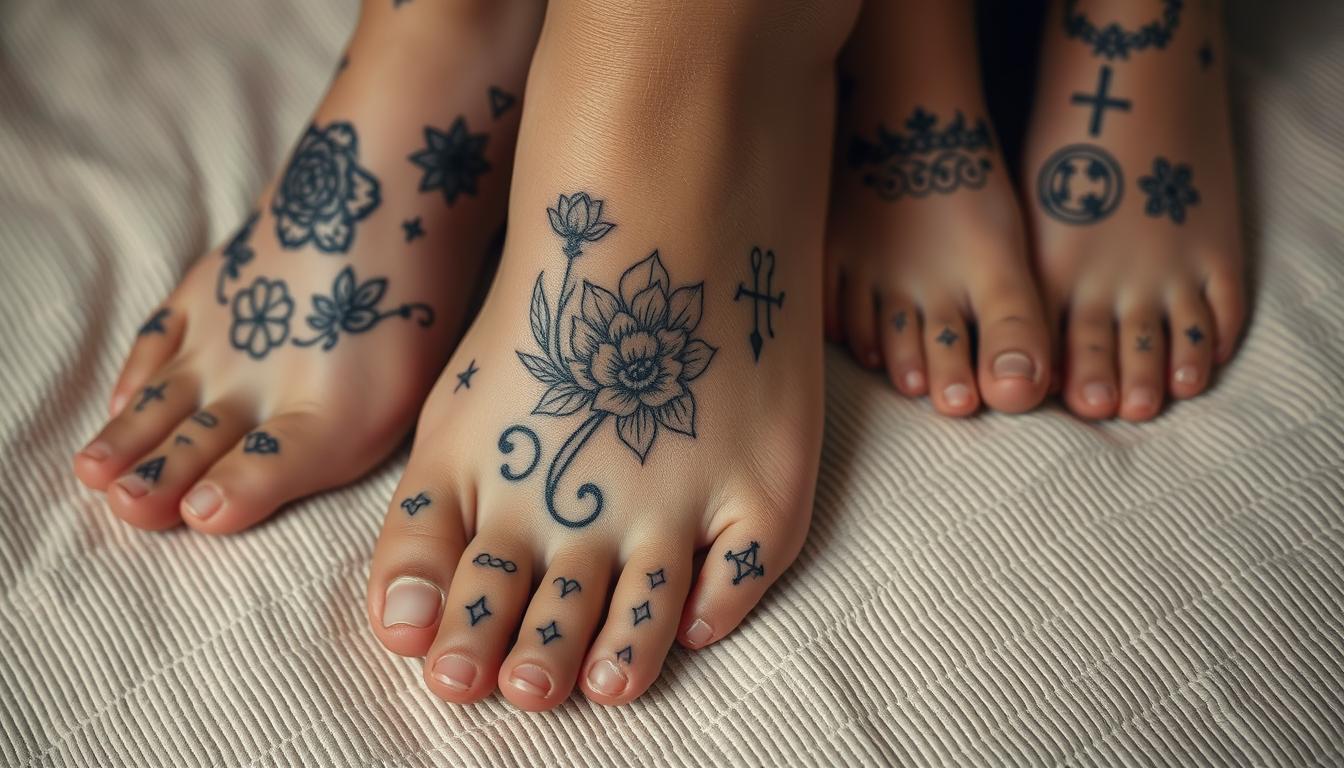
Body art has evolved into a powerful form of self-expression, and one placement continues to capture attention: the lower body canvas. Over the last 10 years, studios report this area ranks among the top five most requested spots, with nearly a third of first-time clients choosing it. Its appeal lies in offering both visibility and subtlety—you can flaunt intricate patterns in sandals or conceal them effortlessly in professional settings.
Why do so many gravitate toward this location? The relatively flat surface allows for flowing, delicate artwork that complements natural curves. From symbolic motifs to abstract patterns, these designs become intimate companions that move with you daily. While they require thoughtful aftercare due to frequent use, their ability to blend personal meaning with practicality keeps them timeless.
This guide helps you navigate everything from style selection to aftercare tips. Whether you’re drawn to minimalist symbols or bold floral arrangements, you’ll discover how to create art that resonates with your story. Let’s explore what makes this placement uniquely rewarding.
Key Takeaways
- Ranked among top 5 most requested placements in U.S. studios
- Offers ideal balance of visibility and discretion
- Flat surface accommodates detailed, flowing designs
- Requires specialized aftercare for longevity
- Suitable for all ages seeking meaningful self-expression
Understanding the Allure of Foot Tattoos
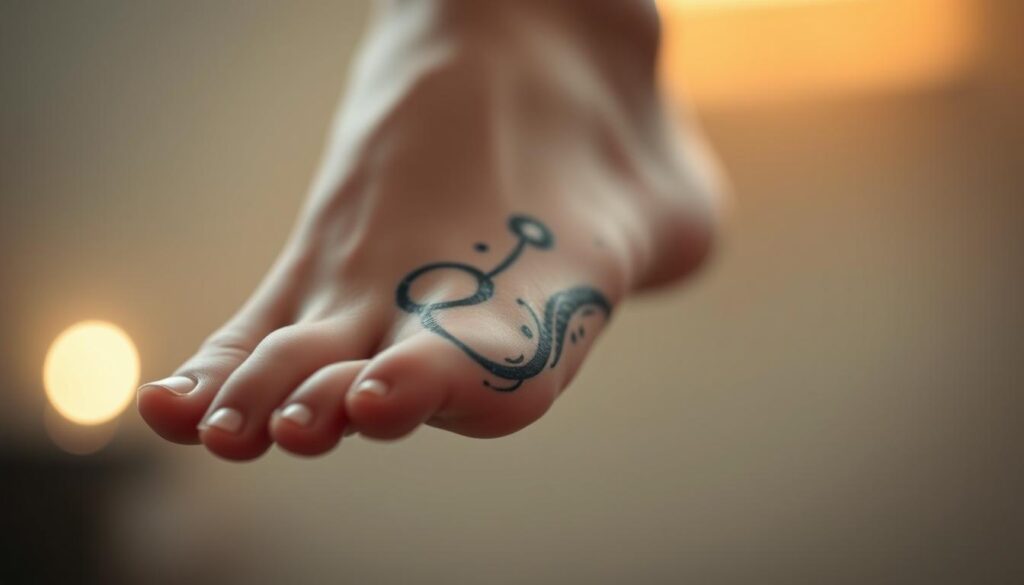
What makes this type of body art so magnetic? It’s the perfect marriage of privacy and creativity. As Sarah, a client from Chicago, puts it: “Mine feels like a hidden compass—always guiding me, but only I know it’s there.” This duality lets you carry deeply personal symbols while keeping them tucked away during meetings or formal events.
You’ll love how these designs adapt to your lifestyle. A delicate vine wrapping around your ankle whispers elegance during weekend outings, while bold geometric shapes make striking statements at beach gatherings. The placement offers just enough skin for meaningful artwork without overwhelming your natural features.
The natural curves of this area inspire artists to craft flowing patterns that mirror movement. Whether it’s a crescent moon following your arch or waves dancing across your instep, each piece becomes an extension of your personality. During warmer months, they spark curiosity and stories—like wearable journals waiting to be shared.
For those in conservative careers or academic settings, this choice balances self-expression with practicality. You maintain professionalism while harboring a secret source of confidence. It’s no wonder people across generations gravitate toward this intimate form of artistry—where every step carries hidden meaning.
Foot Tattoos: Everything You Need to Know
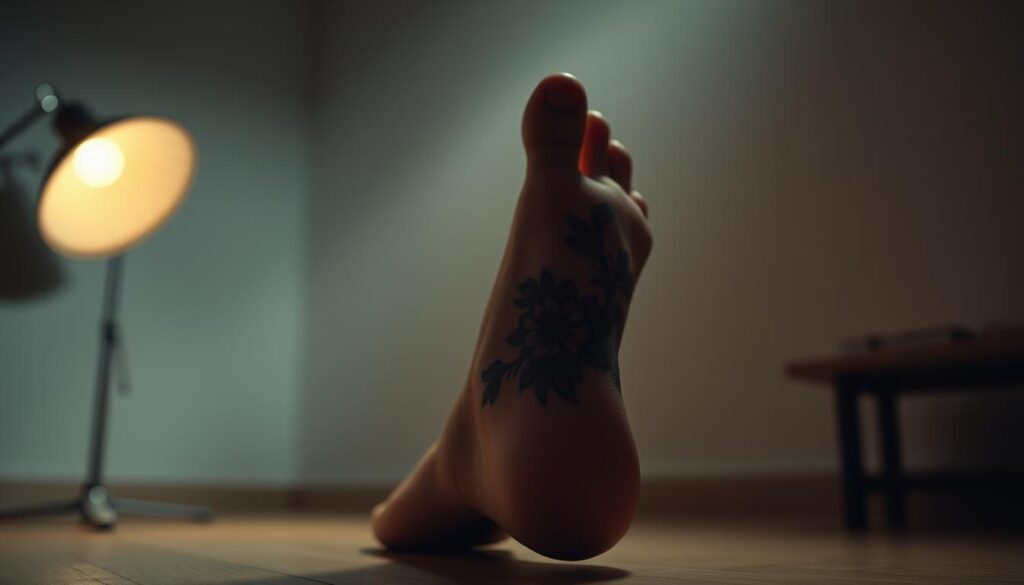
This popular placement offers distinct advantages but comes with its own set of challenges. Whether you’re drawn to discreet symbols or eye-catching art, understanding both sides helps make informed decisions. Let’s break down what makes this choice uniquely rewarding and occasionally demanding.
Pros & Cons at a Glance
What you’ll love: The ability to hide your ink under sneakers or dress shoes makes it ideal for workplaces. Sandal season turns your design into a natural conversation piece. Smaller motifs like stars or initials thrive here, packing meaning into compact spaces.
What to watch for: Needle work near bones and tendons often feels sharper than on fleshier areas. Constant contact with shoes can blur lines over time—proper healing rituals become crucial. Winters might leave your art hidden under layers for months.
Young professionals and seasoned adventurers alike appreciate how this spot balances self-expression with practicality. Just remember: moisture-wicking socks and breathable footwear become your best allies during recovery. With thoughtful planning, your design can stay vibrant through countless steps.
Choosing the Perfect Foot Tattoo Design
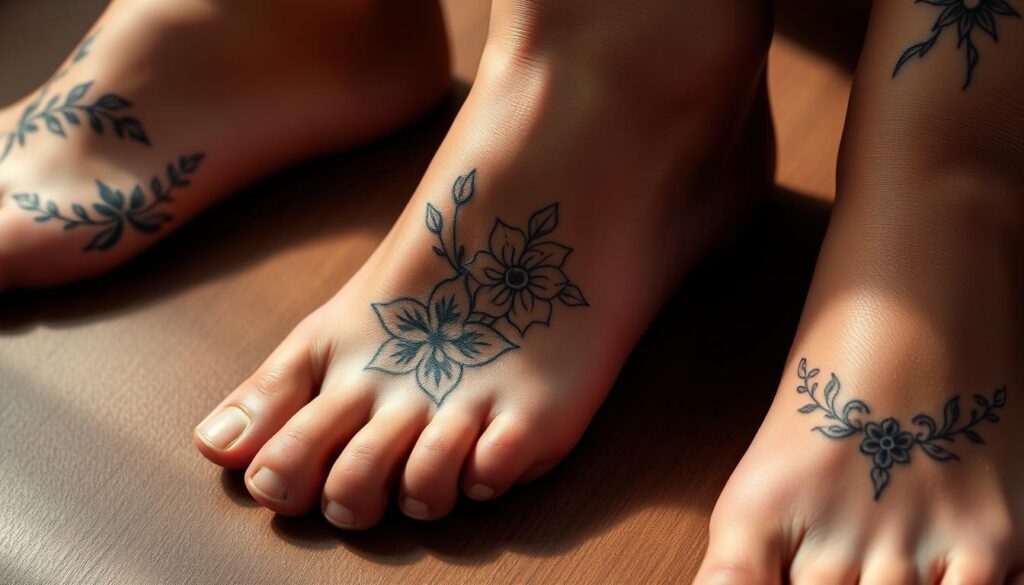
Selecting artwork for this placement offers endless creative paths. Whether you prefer nature-inspired motifs or structured patterns, your choice becomes a wearable story. Let’s explore popular styles that balance meaning with visual harmony.
Floral, Script, and Symbolic Inspirations
Botanical themes dominate requests, with roses and lotuses leading the trend. One client chose cherry blossoms to honor her Japanese heritage—delicate petals trailing along her arch. Quotes in cursive script work beautifully here, transforming personal mantras into permanent reminders.
Symbolic imagery lets you express core values subtly. Anchors represent stability, while birds symbolize freedom. These pieces often hold deeper significance, like a phoenix rising from ashes inked along the instep.
Geometric, Mandala, and Water-Inspired Concepts
Precision meets artistry in angular patterns that accentuate natural lines. Mandalas radiate symmetry from the heel, their intricate details mirroring cosmic balance. Water-themed designs create fluid illusions—think crashing waves or koi fish seeming to swim with each step.
| Style | Best For | Visual Impact |
|---|---|---|
| Floral | Soft, organic shapes | Feminine & timeless |
| Geometric | Modern aesthetics | Bold contrast |
| Water | Dynamic movement | Hypnotic flow |
| Mandalas | Spiritual seekers | Mesmerizing depth |
For those drawn to beautiful floral arrangements, consider seasonal blooms that reflect your personality. Pair them with vines or butterflies for added dimension. Remember: simpler designs often age better in high-movement areas.
Optimal Tattoo Placement for Your Foot
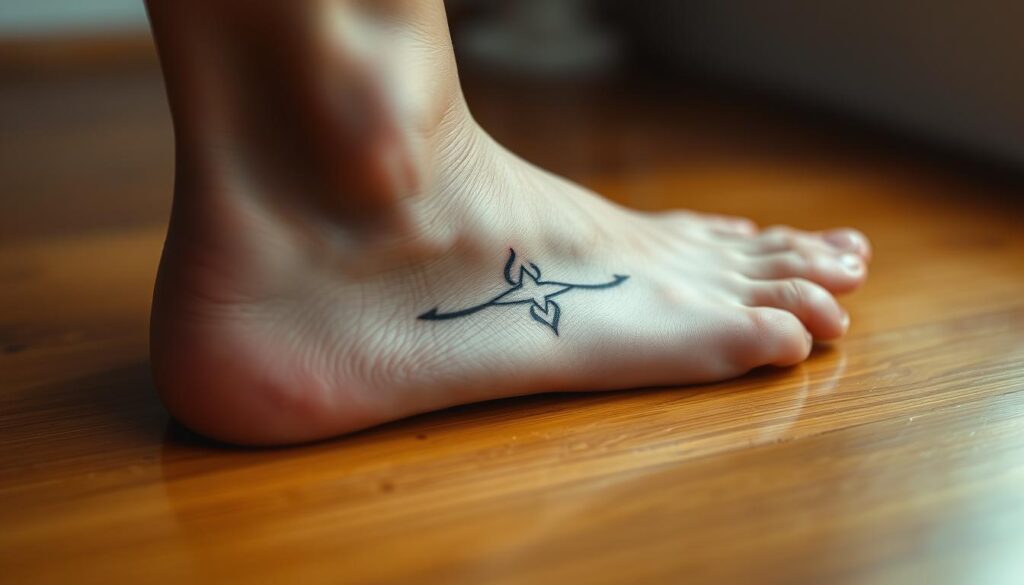
Finding the ideal spot for your design combines anatomy with artistry. Three out of four clients with high arches prefer showcasing bold artwork on the upper surface, while others benefit from creative positioning that enhances their natural features. Let’s explore how to match your unique structure with designs that thrive through every step.
Placement Tips Based on Foot Shape
High arches create a prime canvas for detailed scenes or symbolic motifs along the top area. This space handles intricate linework beautifully, like mandalas or script quotes. Flatter feet often pair best with side placements—these zones stay stable during movement, preserving clarity over time.
Wider shapes shine with wrapping designs that follow natural curves. Think vines circling the instep or waves hugging the outer edge. Narrower profiles suit vertical elements like arrows or floral stems, drawing the eye upward for balanced proportions.
Design Considerations for Ease and Aesthetics
Always test how your artwork adapts to standing versus walking positions. A compass rose might spread perfectly when relaxed but compress slightly during motion. Areas near the ankle offer versatility—they bridge potential future leg art while remaining discreet under socks.
Simplify complex patterns in high-contact zones like the heel or ball. Smaller symbols here withstand friction better than delicate shading. Remember: proper placement isn’t just about looks—it ensures your piece ages gracefully through seasons and shoe changes.
Navigating Pain & Healing Process
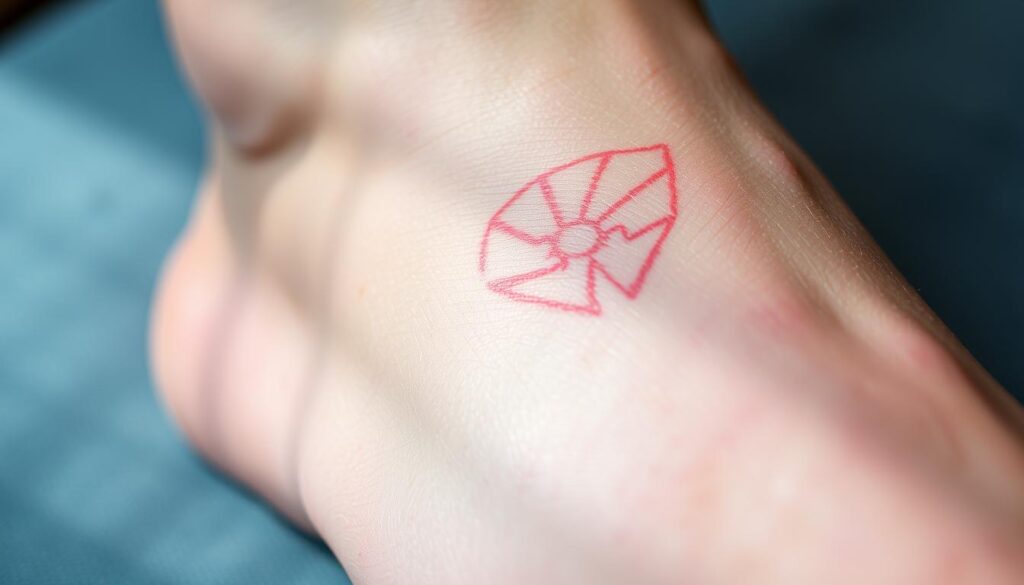
Getting inked in this area demands both courage and preparation. The combination of thin skin, dense nerve clusters, and constant motion creates unique challenges. Let’s break down what your body experiences during and after the process.
Why Sensitivity Varies by Location
Bony areas with minimal cushioning—like the top of your foot—deliver sharper sensations. Clients often describe it as a hot, persistent scratch. Side zones near arches tend to feel more manageable, though individual tolerance plays a big role.
From Fresh Ink to Fully Healed
Expect a three-phase recovery:
- Days 1-7: Redness and swelling peak, requiring elevated rest
- Weeks 2-3: Itching and flaking signal new skin growth
- Month 1+: Colors settle as deeper layers mend
Constant movement in this region extends healing by 3-4 weeks compared to arm designs. Wear loose shoes and avoid pools during early stages. For those reconsidering their ink, proper removal methods exist, but prevention through careful aftercare works best.
Essential Aftercare for Long-Lasting Ink
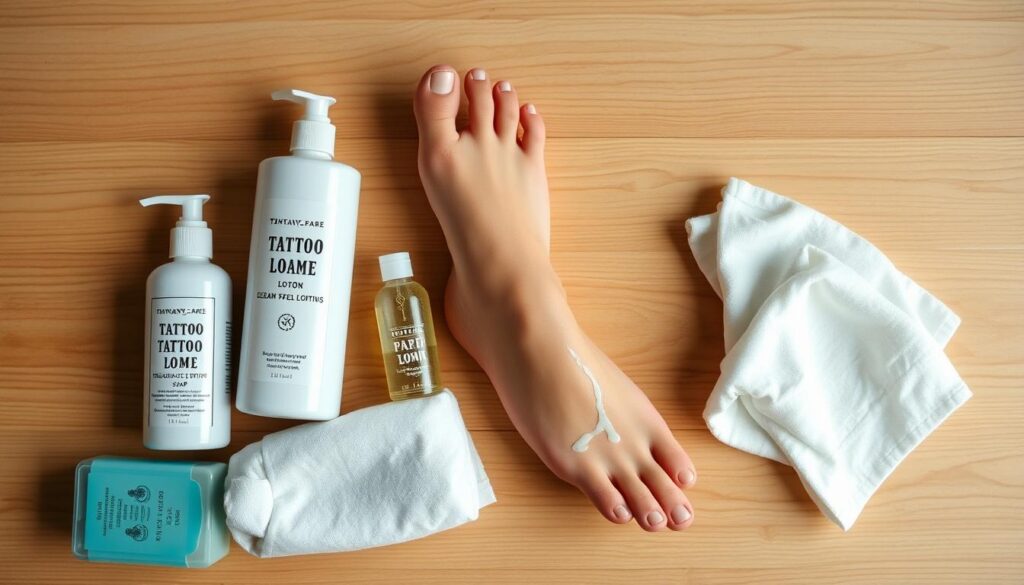
Proper care transforms fresh ink into lifelong art. Studies show diligent tattoo aftercare boosts perfect healing chances by 70%. Your commitment during the first 14 days shapes how your design ages and retains detail.
Immediate Aftercare Steps
Elevate your foot whenever sitting to reduce swelling. Clean gently twice daily with fragrance-free antibacterial soap—pat dry with paper towels. Apply ointment in rice-grain amounts 3-4 times daily.
Avoid shoes when possible. If needed, choose breathable cotton socks and loose sneakers. Never submerge your skin in water for three weeks—quick showers only. Sleep without covers to maximize air flow.
Long-Term Maintenance to Prevent Fading
Apply SPF 50+ sunscreen before sandal season. Moisturize daily with unscented lotion to combat dryness from shoes. Schedule touch-ups every 2-3 years to refresh colors.
| Care Phase | Key Action | Frequency |
|---|---|---|
| First Week | Ointment application | 3-4x daily |
| First Month | Moisturizing | 2x daily |
| Ongoing | Sun protection | When exposed |
| Yearly | Artist checkups | 1x annually |
Remember: friction from footwear and sun exposure accelerates fading. Protective measures keep your artwork vibrant through countless steps and seasons.
Seasonal Considerations for Foot Tattoos
Timing your ink session can make all the difference in achieving crisp, lasting results. While summer tempts with sandal weather, studies show a 35% higher risk of healing issues during peak heat months. Sweat, sun, and water activities create a trifecta of challenges for fresh designs.
Ideal Seasons for New Artwork
Fall and winter offer hidden advantages. Cooler temperatures let you wear protective footwear without discomfort, shielding your design during its delicate proper healing process. Covered feet also minimize UV exposure—a key factor since sunlight breaks down pigments faster.
Year-Round Care Strategies
Apply SPF 50+ whenever your skin sees daylight, even through clouds. Choose breathable shoes during the first 4 weeks to reduce friction. If summer sessions are unavoidable, plan around water activities and prioritize loose socks.
Pro tip: Schedule touch-ups during cooler months when footwear choices support aftercare. Your art will thank you by staying vibrant through countless seasons.
